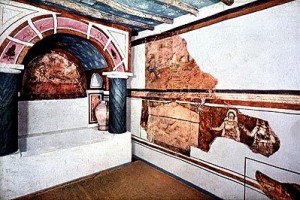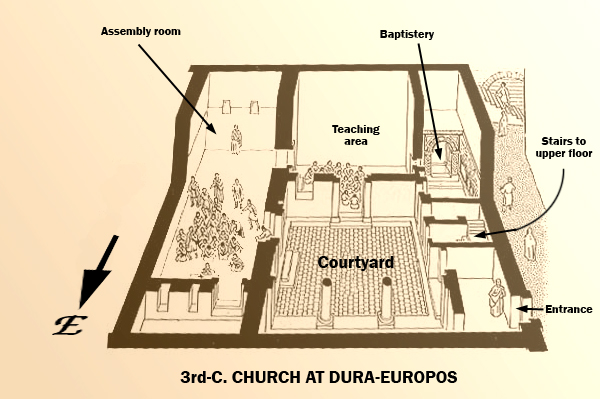The Catholic Faith was illegal in the Roman Empire prior to 313 A.D., when the Emperor Constantine issued the Edict of Milan permitting it to flourish publicly. Prior to that time, Church buildings as we know them today were rare – Mass was usually celebrated in houses.
These “houses” were usually rather sizable, with a central courtyard or large room that permitted something a little more formal than Mass around the dining room table. I remember being taught (incorrectly) that these early Masses were informal, celebrated facing the people, and had a relaxed, communal atmosphere. In fact, the people didn’t just sit around a table or on the floor in circle – not at all. They sat or stood formally, with everyone faced in one direction: east.
The drawing above shows the layout of an ancient house church (more often called a Domus Dei (House of God)), based on an excavated 3rd century house church in Dura-Europos (located in what is now Syria).

The assembly room is on the left, and a priest or bishop is depicted conducting a liturgy (facing east) at an altar against the east wall. A baptistry is on the right, and a deacon is shown guarding the entrance. The lonely-looking deacon in the back of the assembly hall is there to “preserve good order,” as you will read below.
What is remarkable about these early liturgies is how formal they were despite the less-than-ideal circumstances. The following text is from the Didiscalia, a document written in about 250 A.D. Among other things, it gives rather elaborate details about the celebration of the early Catholic Mass in these “house liturgies.” I have included an excerpt below (in bold italics); my comments are shown in red text.
Now, in your gatherings, in the holy Church, convene yourselves modestly in places of the brethren, as you will, in a manner pleasing and ordered with care.
These “house liturgies” were not informal; good order and careful attention to detail were essential.
Let the place of the priests be separated in a part of the house that faces east.
Even in these early house Masses, the sanctuary (where the clergy ministered) was distinct from where the laity gathered. People were not all just clustered around a dining room table.
In the midst of them is placed the bishop’s chair, and with him let the priests be seated. Likewise, and in another section let the lay men be seated facing east. For thus it is proper: that the priests sit with the bishop in a part of the house to the east and after them the lay men and the lay women,
Everyone faced east, laity and clergy. Notice that men and women sat in separate sections, which was the tradition in many churches until relatively recently (the last 150 years or so).
and when you stand to pray, the ecclesial leaders rise first, and after them the lay men, and again, then the women. Now, you ought to face to east to pray for, as you know, scripture has it, Give praise to God who ascends above the highest heavens to the east.
Again, note that Mass was not celebrated facing the people, as some suppose of the early Church. Everyone faced in the same direction: east. The text cites Scripture as the reason for this: God is to the east, the origin of the light.
Now, of the deacons, one always stands by the Eucharistic oblations and the others stand outside the door watching those who enter,
Remember that this was a time of persecution; the early Christians were careful to allow only baptized and bona fide members to enter the sacred mysteries. Only the baptized were permitted to enter the Sacred Liturgy. This was called the disciplina arcanis (discipline of the secret), and deacons guarded the door to maintain it.
and afterwards, when you offer let them together minister in the church.
Once the door was locked and the Mass began, it would seem that the deacons took their place in the sanctuary, with one remaining outside it to maintain “good order” among the laity.
And if there is one to be found who is not sitting in his place let the deacon who is within, rebuke him, and make him to rise and sit in his fitting place … also, in the church the young ones ought to sit separately, if there is a place, if not let them stand. Those of more advanced age should sit separately; the boys should sit separately or their fathers and mothers should take them and stand; and let the young girls sit separately, if there is really not a place, let them stand behind the women; let the young who are married and have little children stand separately, the older women and widows should sit separately.
This may seem a bit complicated, but the upshot is that seating was by sex and age. Note that those with young children were to stand in a separate area (the cry rooms of the day!).
And a deacon should see that each one who enters gets to his place, and that none of these sits in an inappropriate place. Likewise, the deacon ought to see that there are none who whisper or sleep or laugh or nod off.
The early Christians did such things? Say it isn’t so! Today, ushers preserve “good order.”
For in the Church it is necessary to have discipline, sober vigilance, and attentive ear to the Word of the Lord.
Well, that is clear and to the point – and the advice is still needed. It is also a fitting way to end today’s post.
Cross-posted at the Catholic Standard: The Ancient Mass in “House Churches” Was Not as Informal as Many Think


I’m not so sure that things were quite so formal in the New Testament Church. Paul encourages the people at the Lord’s Supper to be more reverent (1Corinthians 11:18-34).
Almost as if there was a focus on it…